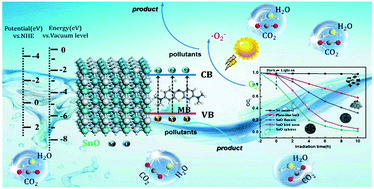当前位置:
X-MOL 学术
›
CrystEngComm
›
论文详情
Our official English website, www.x-mol.net, welcomes your
feedback! (Note: you will need to create a separate account there.)
Morphology modulation of SnO photocatalyst: from microplate to hierarchical architectures self-assembled with thickness controllable nanosheets
CrystEngComm ( IF 2.6 ) Pub Date : 2018-07-13 00:00:00 , DOI: 10.1039/c8ce00687c Rui Zhang 1, 2, 3, 4, 5 , Qi Wang 1, 2, 3, 4, 5 , Jun Zhang 1, 2, 3, 4, 5 , Lili Yin 1, 2, 3, 4, 5 , Yao Li 1, 2, 3, 4, 5 , Shu Yin 6, 7, 8, 9 , Wenbin Cao 1, 2, 3, 4, 5
CrystEngComm ( IF 2.6 ) Pub Date : 2018-07-13 00:00:00 , DOI: 10.1039/c8ce00687c Rui Zhang 1, 2, 3, 4, 5 , Qi Wang 1, 2, 3, 4, 5 , Jun Zhang 1, 2, 3, 4, 5 , Lili Yin 1, 2, 3, 4, 5 , Yao Li 1, 2, 3, 4, 5 , Shu Yin 6, 7, 8, 9 , Wenbin Cao 1, 2, 3, 4, 5
Affiliation

|
Shape-controllable SnO microstructures were successfully synthesized via a facile inorganic alkali-assisted hydrothermal method. The morphologies of the prepared samples could be simply modulated from plate-like blocks to hierarchical architectures assembled using nanosheets with tuned thicknesses, including flowers, bird nests and microspheres, through varying the alkali used in the synthesis process. Based on the experimental results, the origins and detailed formation mechanisms of the plate-like and hierarchical SnO architectures were comprehensively proposed. It was found that the formation of SnO was governed by dissolution–recrystallization and an oriented attachment process; the different dissociation rates of various alkalis played an important role in the final SnO morphology. The thicknesses of the assembling nanosheets greatly decreased with an increase in the dissociation rates of the alkalis. Furthermore, it was proved experimentally that all the hierarchical SnO structures exhibited better photocatalytic activities than those of the plate-like structures in the photodegradation of MB under fluorescent and UV light irradiation. The microspheres, with decreased size and assembling nanosheets of decreased thickness, showed the highest activity for MB dye degradation owing to an increased specific surface area and the reduced recombination of photogenerated electron–hole pairs. The mechanism for the photocatalytic degradation of MB over SnO was discussed in detail.
中文翻译:

SnO光催化剂的形态学调节:从微孔板到具有可控制厚度的纳米片自组装的分层体系结构
形状可控的SnO微观结构已成功通过一种简便的无机碱辅助水热法。可以通过改变合成过程中使用的碱,将制备好的样品的形态从板状块简单地调制为使用厚度可调的纳米片组装而成的分层结构,包括花,鸟巢和微球体的厚度。根据实验结果,全面提出了板状和分层SnO架构的起源和详细的形成机理。结果发现,SnO的形成受溶解-重结晶和定向附着过程的控制。各种碱的不同解离速率在最终的SnO形态中起着重要作用。随着碱解离速率的增加,组装纳米片的厚度大大降低。此外,实验证明,在荧光和紫外光照射下,MB的光降解过程中,所有的SnO分层结构都比板状结构表现出更好的光催化活性。具有减小的尺寸和厚度减小的组装纳米片的微球由于增加了比表面积和减少了光生电子-空穴对的重组而显示了MB染料降解的最高活性。详细讨论了在SnO上MB的光催化降解机理。具有减小的尺寸和厚度减小的组装纳米片,由于增加了比表面积和减少了光生电子-空穴对的重组,显示了MB染料降解的最高活性。详细讨论了在SnO上MB的光催化降解机理。具有减小的尺寸和厚度减小的组装纳米片,由于增加了比表面积和减少了光生电子-空穴对的重组,显示了MB染料降解的最高活性。详细讨论了在SnO上MB的光催化降解机理。
更新日期:2018-07-13
中文翻译:

SnO光催化剂的形态学调节:从微孔板到具有可控制厚度的纳米片自组装的分层体系结构
形状可控的SnO微观结构已成功通过一种简便的无机碱辅助水热法。可以通过改变合成过程中使用的碱,将制备好的样品的形态从板状块简单地调制为使用厚度可调的纳米片组装而成的分层结构,包括花,鸟巢和微球体的厚度。根据实验结果,全面提出了板状和分层SnO架构的起源和详细的形成机理。结果发现,SnO的形成受溶解-重结晶和定向附着过程的控制。各种碱的不同解离速率在最终的SnO形态中起着重要作用。随着碱解离速率的增加,组装纳米片的厚度大大降低。此外,实验证明,在荧光和紫外光照射下,MB的光降解过程中,所有的SnO分层结构都比板状结构表现出更好的光催化活性。具有减小的尺寸和厚度减小的组装纳米片的微球由于增加了比表面积和减少了光生电子-空穴对的重组而显示了MB染料降解的最高活性。详细讨论了在SnO上MB的光催化降解机理。具有减小的尺寸和厚度减小的组装纳米片,由于增加了比表面积和减少了光生电子-空穴对的重组,显示了MB染料降解的最高活性。详细讨论了在SnO上MB的光催化降解机理。具有减小的尺寸和厚度减小的组装纳米片,由于增加了比表面积和减少了光生电子-空穴对的重组,显示了MB染料降解的最高活性。详细讨论了在SnO上MB的光催化降解机理。











































 京公网安备 11010802027423号
京公网安备 11010802027423号